Scandinavian people with revolutionary ideas and sometimes barbaric practices, the Vikings have a history mixed with fear and fascination. Immerse yourself in the tale of the great Viking discoveries, and navigate the waters of a troubled history.
Summary
- 1. Discovery of the ice island
- Naddoddr and Gardar Svavarsson: The great firsts
- Flóki, the architect with crows
- Ingolfur Arnarson, the legend of Reykjavik
- 2. Thingvellir, Legacy of a New World
- Territorial conflicts and wars: the first steps towards peace
- Thingvellir, the oldest parliament in history
- Thingvellir’s Big Decision
- 3. The legendary Icelandic waterfalls
- Skógafoss
- Godafoss
- Seljalandsfoss
Warriors, pirates, raiders. Violent, bloodthirsty, merciless. There are many qualifiers given to the Viking people. Legendary population, almost mythological, it intrigues us as much as it frightens us. However, did you know that the majority of writings telling the stories of these “terrible Vikings” were written by Christians, a population victim of their colonization?
So if, together, we give the benefit of the doubt to this pagan people? Great explorers thirsty for discoveries, architects, craftsmen precursors and traders of great talents, today we reveal the little-known portrait of the Vikings.
In this journey through time, we invite you to re-write together the history of their greatest discoveries.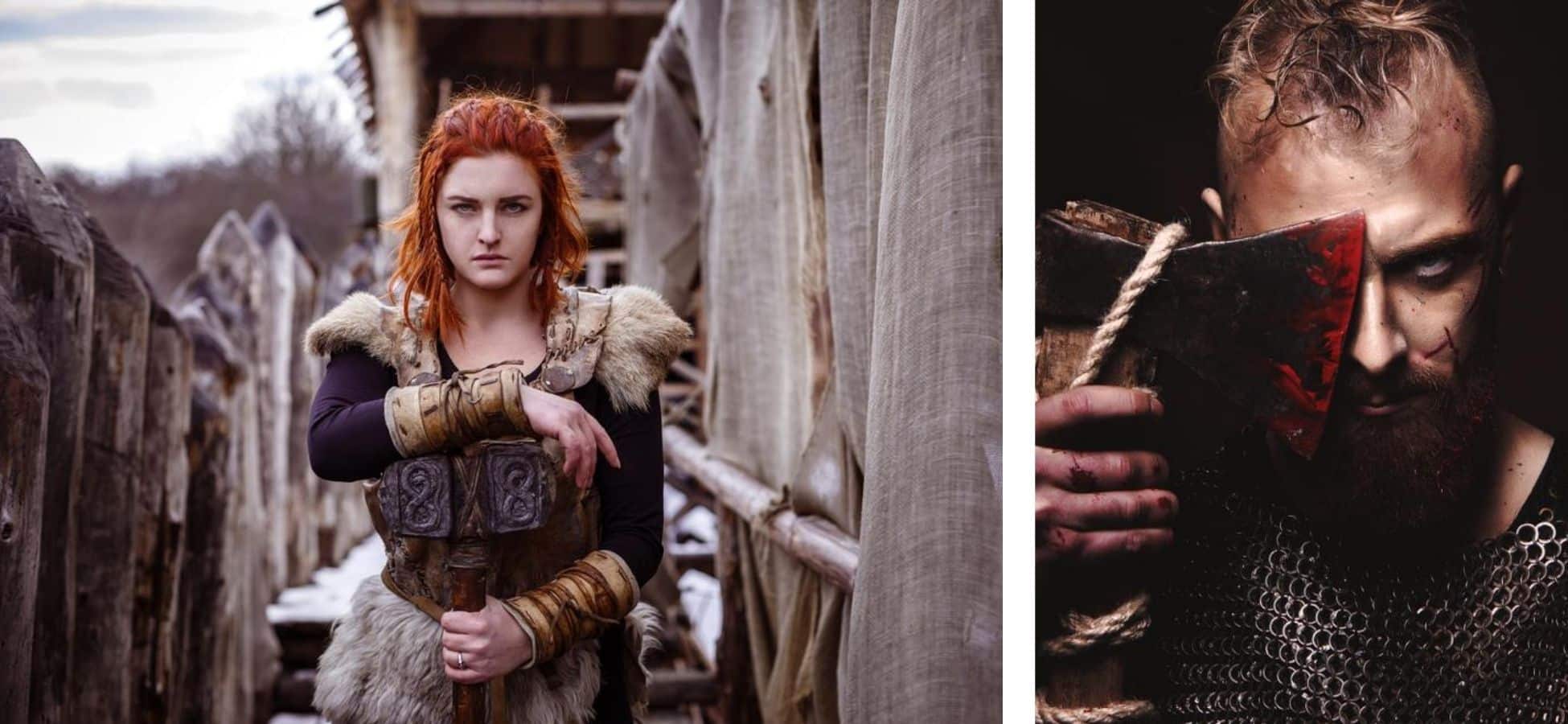
Photo credit: Shutterstock – Selenit & Feel Freedom
In this first episode, let’s stop in a land almost as legendary as the people who discovered it, Iceland . In the footsteps of the first Viking explorers, here you are in sublime land, in hostile territory.
1. Discovery of the ice island
If we know that the Vikings came from Scandinavian countries, such as Sweden or Norway , it is however difficult to date the exact appearance of this people, estimated around the year 750. And for good reason, until the 12th century. century, the Vikings only appear in Christian manuscripts from the ancient kingdom of England, land of the first barbarian invasions. A necessarily biased vision of this people, and telling the terrible legends that we know today about a bloodthirsty population.
It was only four centuries later that the first manuscript written by the hand of the Viking heirs appeared: the Landnámabók . Thus was born the first saga in history . The book recounts, for the first time and in great detail, the first real discovery and colonization of the Scandinavian people, that of Iceland.
Naddoddr and Gardar Svavarsson: The big firsts
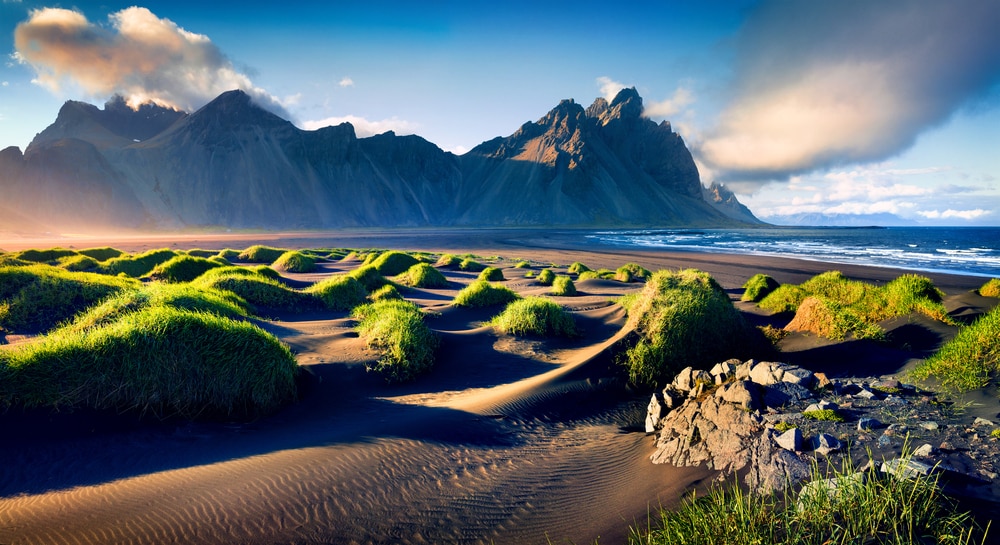
Black sand dune – Stokksnes, Iceland – Photo credit: Shutterstock – Andrew Mayovskyy
It is therefore by relying on the writings of Landnámabók that we begin our story, with Naddoddr , a Norwegian Viking whose evocation takes us back to the middle of the 9th century. We are in 861 when, wishing to find the lands of the Faroe Islands, Naddoddr and his crew drift away. So lost between the North Sea and the Norwegian Sea, the sailors finally ran aground on the east coast of Iceland, in Reyðarfjall.
Determined to find their Faroese lands to become the first settlers, Naddoddr and his crew do not drag on, and quickly go back to sea. When they leave, snow begins to fall on the Icelandic coasts. Inspired by this white coat, the Viking then decided to baptize the country Snaeland , the land of snow.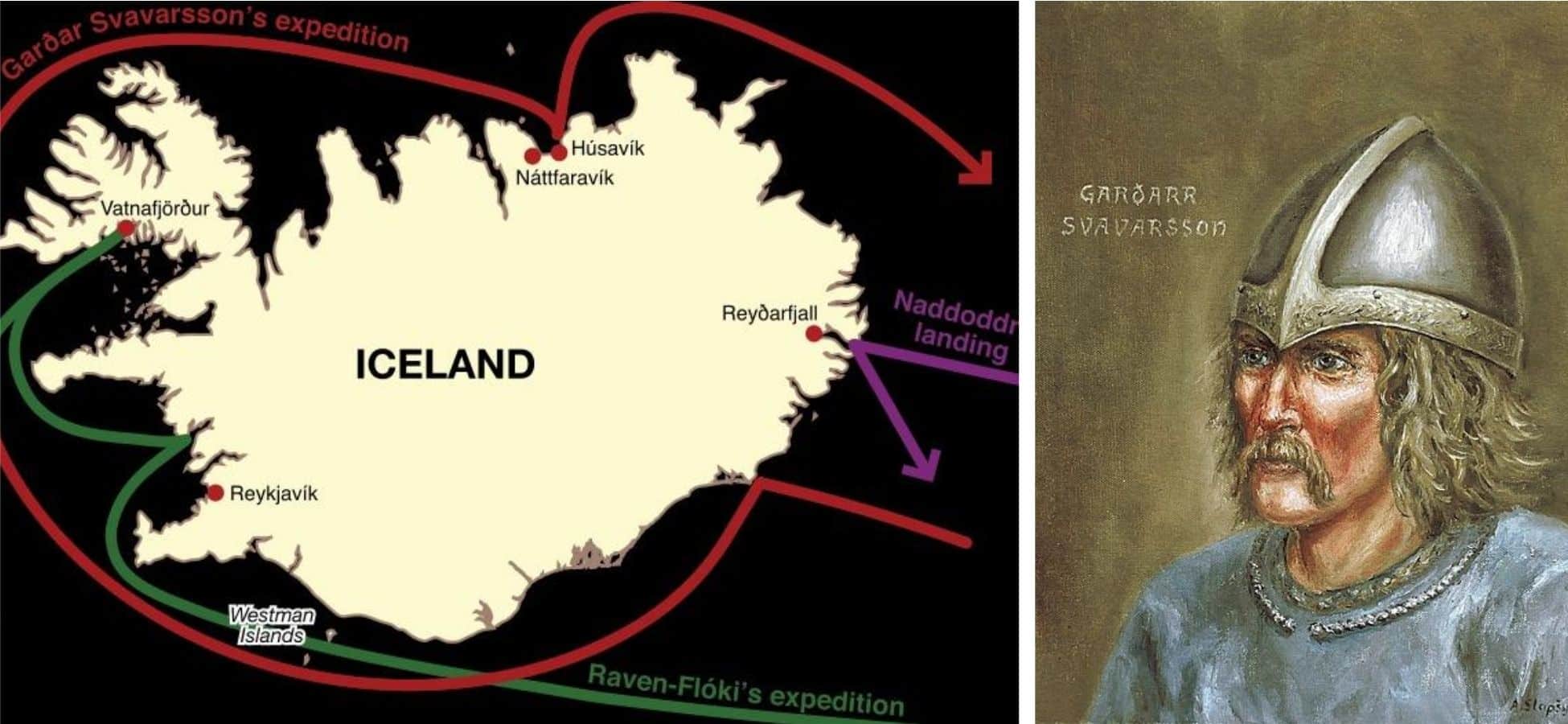
Map of the discoveries of Iceland / Portrait of Gardar Svavarsson – Photo credit: Wikipedia – Max Naylor & Artūras Slapšys
For several years, Snaeland remained uninhabited. Until this new time when, chance brings in a new Viking crew: that of the Swedish Gardar Svavarsson . Seeking his father-in-law’s legacy, Gardar sets sail for the Hebrides . His drakkar finds himself caught in the middle of a storm, resisting the winds and the tides, but unable to fight against the currents, which end up diverting his path towards the North.
Once on the east coast, Gardar and his men set out to bypass the territory. But here it is: the land they are treading on has no borders. Gardar Svavarsson is therefore the first Viking to have defined Iceland as an island. On the strength of this discovery and conquered by the beauty of the landscape, he then decided to spend the winter there. It was in the province of Skjálfandi, now called Húsavík, that he established the first Viking camp in Iceland.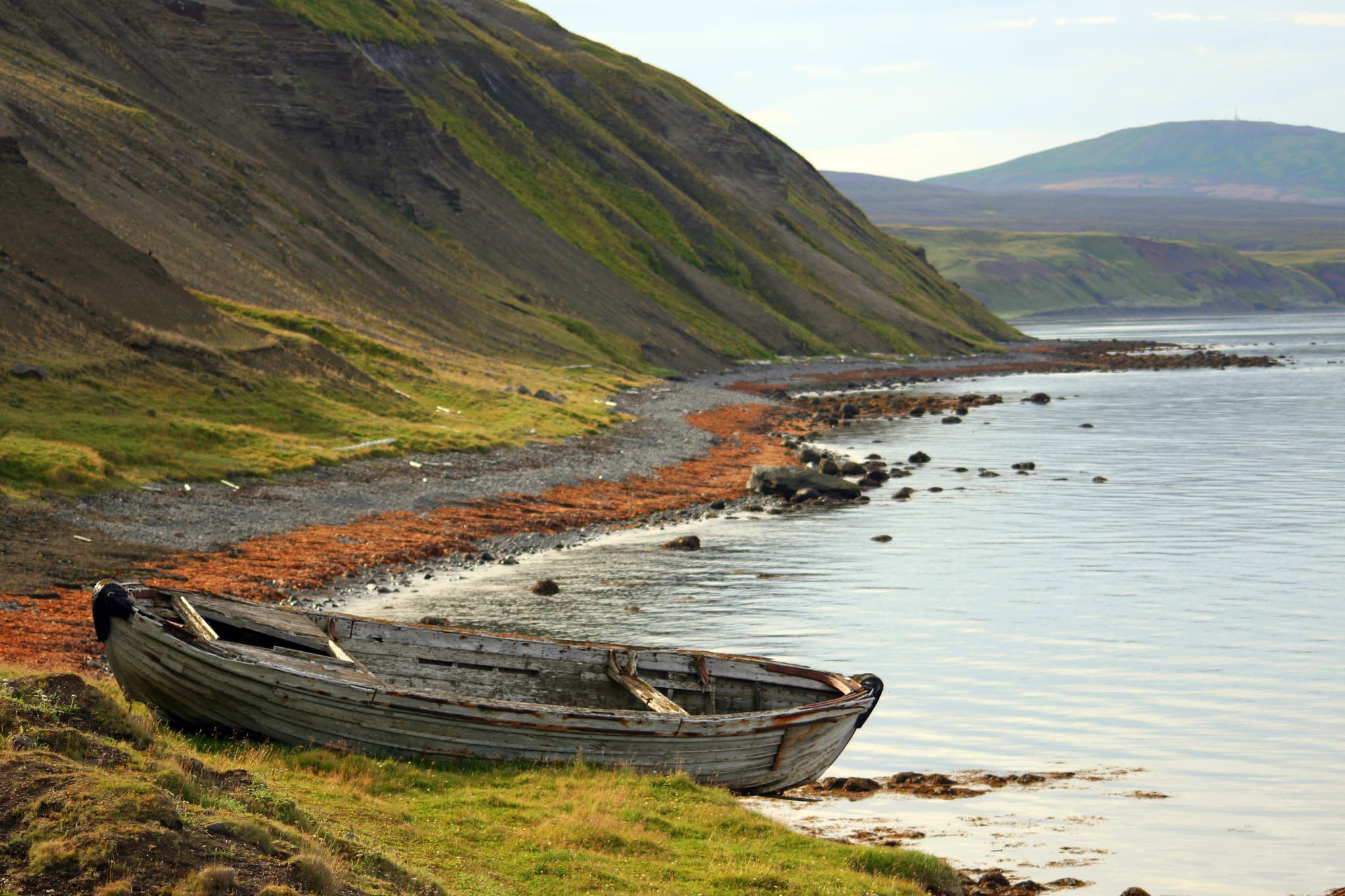
Tungulending, bordering the province of Húsavík, Iceland – Photo credit: Flickr –
VisitHusavik
Once the winter has passed and the waters have calmed down, Gardar Svavarsson decides to return to Norway, with the idea of sharing his crazy discovery with the other Vikings, who are never short of good stories. But when leaving Snaeland , one of his slaves, Náttfari , flees with a man and a woman, thus becoming the first permanent residents of a land that will soon become Iceland, land of ice.
Flóki, the architect with crows
Our story continues, and takes a decisive turn for the History of Iceland, as for the History of the Vikings. And if we were to personify this turn, it would take the name of Flóki Vilgerðarson , also named Flóki with the crows .
We are only a few years after Gardar ‘s return to Norwegian lands, and the legend is on. A legend telling the story of an uninhabited land, full of beaches and plains. A land blessed by the gods, ready to welcome pagans and cattle to establish new businesses and expand the Scandinavian colonies.
To these stories, Flóki , a descendant of the ancient kings of the province of Hedemark – but more attracted by adventure than by power – is not insensitive. Unable to deny his attraction to the gods or his desire for discovery, the Viking very quickly made the choice to assemble a crew to conquer this divine land.
Once the construction of the boat is completed, he then goes in search of men or women ready to accompany him. Only, few are those who wish to accompany him in such a great adventure. After all, this new world fascinates as much as it frightens.
Regardless, after gathering three men, Flóki boards his modest longship. Head north.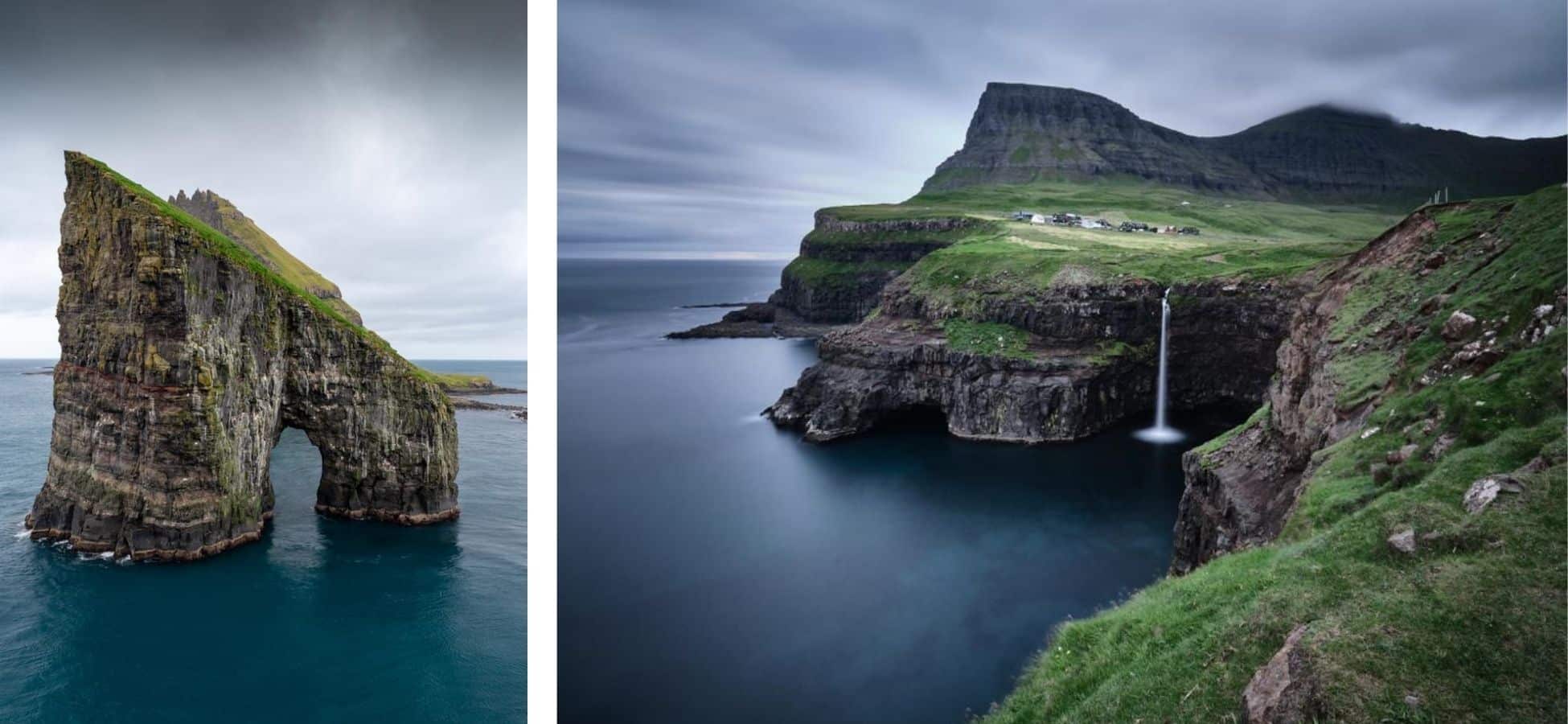
Drangarnir & Gasaladur, Faroe Island – Photo credit: Shutterstock – Costas Kariolis & Albert Photo
In this makeshift crew, Floki notably welcomes three curious travelers, known for their orientation skills: crows. After passing the Faroe Islands, he releases a first crow, which unfortunately leaves for the Faroese coast. The next day, he releases a second. Once again, the bird goes back. So, Flóki decides to let the current carry him for several days, before finally releasing the third crow…
This time, the bird is headed forward, proving to the navigator that the much sought-after lands are closer than ever. He and his poor crew then follow the direction taken by the bird, until finally seeing a large bay. Even today, this bay bears the name of Faxafloi , bay of “Faxi” , one of Flóki ‘s companions , because he was the first to see the long-awaited land.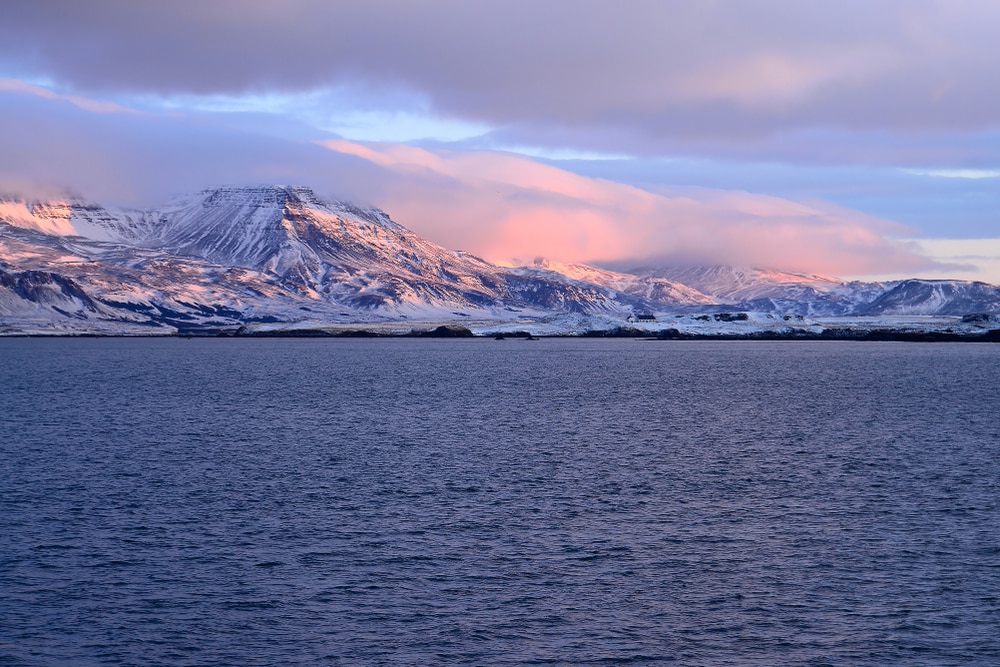
Faxafloi Bay, Iceland – Photo credit: Shutterstock – Paul B. Moore
Finally, it is on the beach of Barður that Flóki decides to set up camp, accompanied by his three companions, and some livestock. After a difficult winter for Vikings still unaccustomed to such harsh weather, the few animals brought by them succumbed, and the reserves were dwindling. Spring, also offering an inclement climate, is a new ordeal for Flóki and his men.
So, the explorer decides to conquer this new country, hoping to find more welcoming lands there. Courageous, it is alone that he climbs a high mountain in order to find a point of view overlooking the whole territory. Only, after such an effort, his disappointment is immense. The earth, which surrounds it as far as the eye can see, is white, icy, hostile… unusable. This is how he then became the first to name the country “Ice land”, land of ice, which would eventually become “Iceland”.
Skaftafell Glacier, Iceland – Photo credit: Shutterstock – Guitar photographer
Returning to the camp, Flóki with the crows resigns himself to waiting for better days, in order to take the sea to return to Norway. Unfortunately, the seasons prove difficult and the sea impassable, forcing Floki and his crew to wait one more year on this land. Eventually back in Norway, and when questioned about the value of these divine lands, Flóki explains that they were worthless. His sailing companion, Herjólfur, confesses that for him Iceland is a hostile land, which has as many faults as it has qualities.
Ingolfur Arnarson, the legend of Reykjavik
Flóki will therefore remain the first Viking to have intentionally sailed towards Iceland, and even gave it the name it still bears today. However, other Vikings will have marked the history of the country.
Indeed, we are in the mid-870s when Ingolfur Arnarson , a Norwegian Viking, was forced to leave the country after a quarrel with Earl Atli. But he does not leave alone: his friend, Hjörleifr Hróðmarsson leaves his family to accompany him. Both, having heard of the exploits of Gardnar and Flóki , see it as an opportunity. The possibility of a bright future that will allow them to go from “rejected” to great explorers.
It’s a real flair, because in 874, they finally land on the Icelandic coast. As they approach, Arnarson offers the wooden edges of his sacred high-seat to the sea. Sculpted in the effigy of the Gods, the latter will drift to the shore, and will indicate the location of the future colony.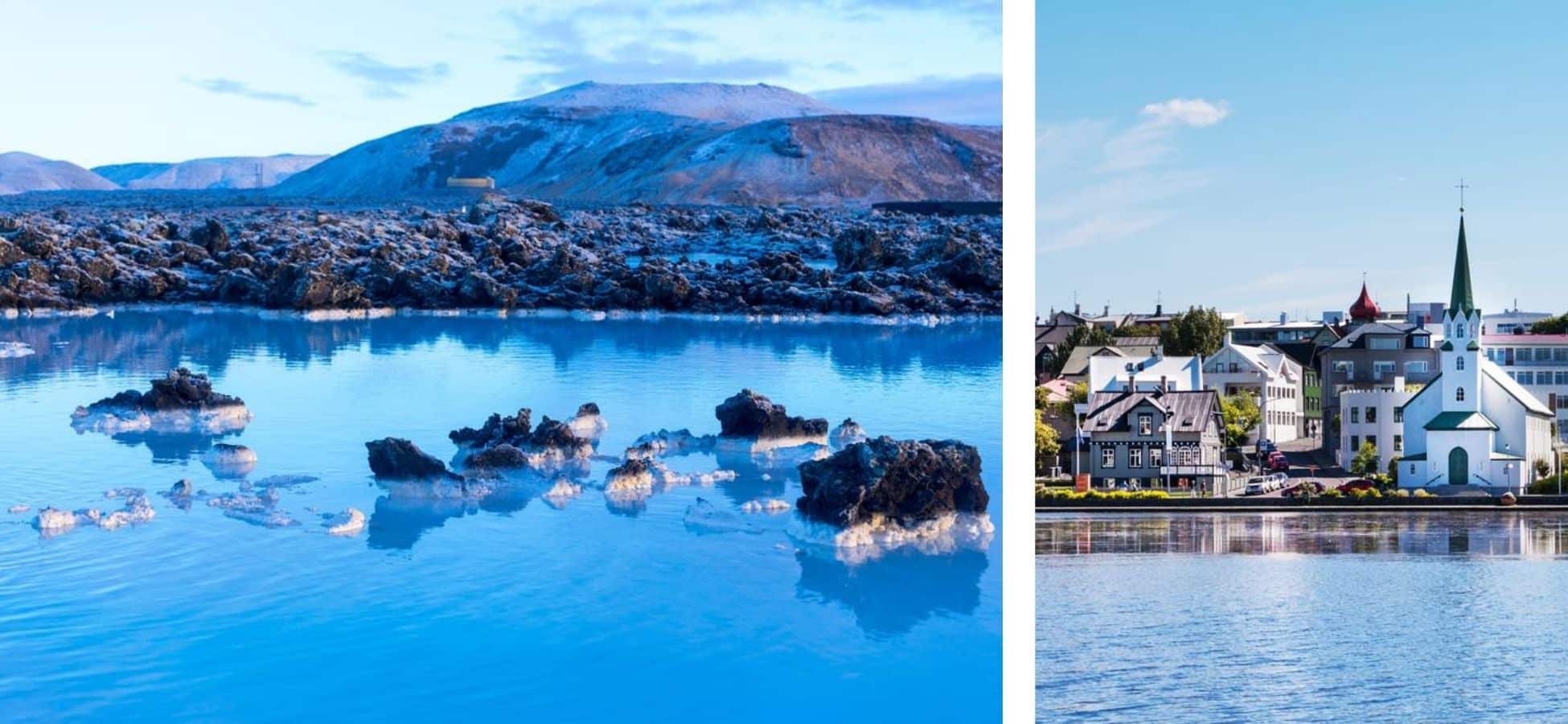
Reykjavik Blue Lagoon & Reykjavik, Iceland – Photo credit: Shutterstock – klenger & Studio Dagdagaz
It will take more than three years for Arnarson ‘s men to find the wooden pillars, nestled in Reykjavik Bay. This is how this city very quickly became one of the country’s flagship places, until becoming its capital almost a millennium later, in 1845. Thus, Arnarson was the first Viking recognized as a permanent resident of the ‘Iceland. However, his companion and friend, Hjörleifr Hróðmarsson, was not so lucky. He was murdered a few months after their arrival on the island, by Irish slaves.
But if at this time again, the pagan people have only proven their ability to explore, the land on which they have just arrived will completely shake things up. Indeed, the Viking people are preparing to change the face of the world, by creating the first parliament in history.
2. Thingvellir, Legacy of a New World
Conflicts and turf wars: the first steps towards peace
Thanks to the explorations, fabulous for the time and carried out by the Vikings whose history we now know, Iceland is gradually revealed. Then the wonders she harbors are revealed to the pagan people, and the news spreads. It will not take more than ten years for hundreds of longships to moor on the Icelandic coasts, and for the lands to fill with Vikings.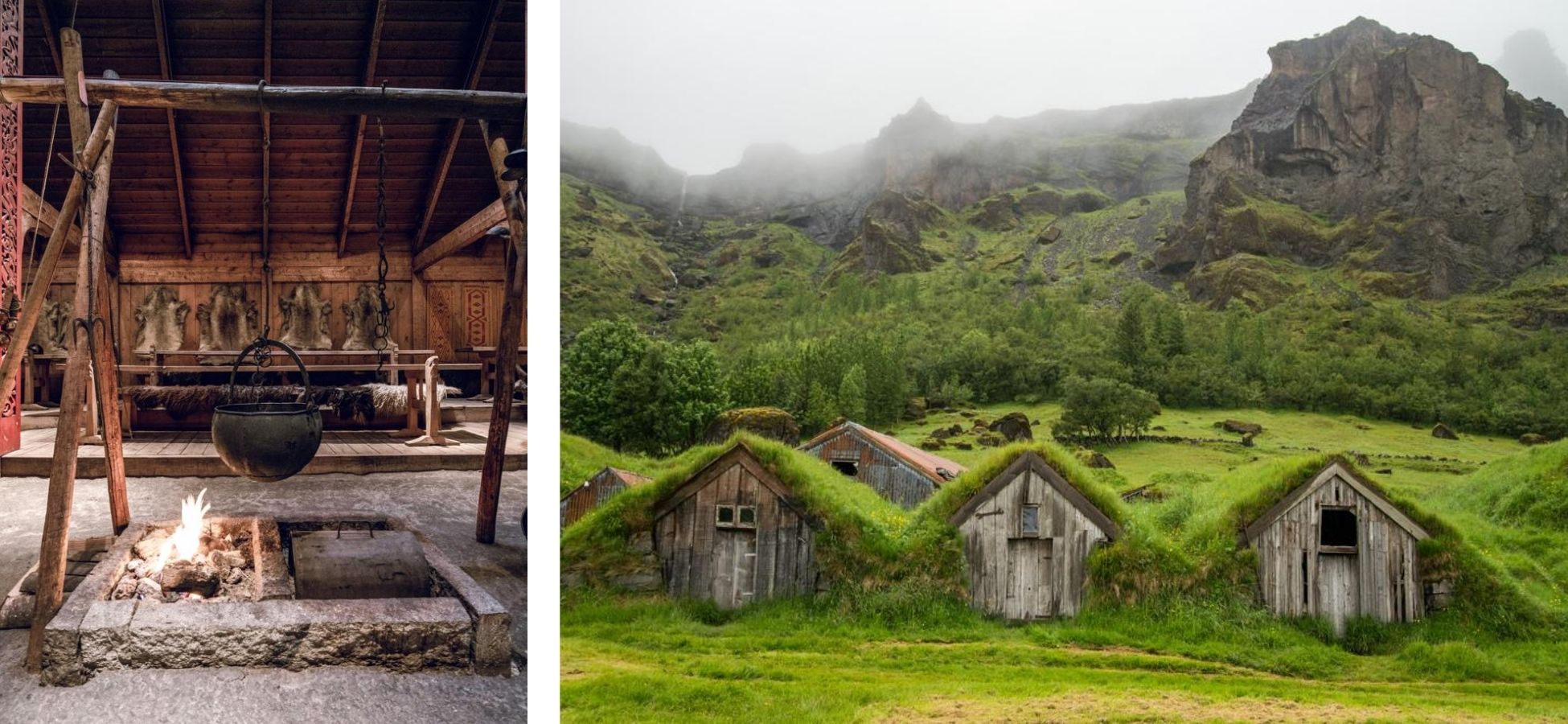
Reconstruction of Viking houses, Iceland – Photo credit: Shutterstock – jonanderswiken & Olja Reven
However, they come from different countries, regions and therefore different societies. Norwegians, Swedes, Danes… Each group of Vikings necessarily has different habits, customs and lifestyles.
So obviously, during the first years, conflicts of egos and wars of territories are born, in particular with the descendants of Ingolfur Arnarson , become meanwhile the most powerful family of Iceland. Conflicts that will eventually lead to the greatest social invention of the Viking population. It is above all to counter this expansion and in the fear of having to undergo a new royalty that the conflicts cease, and that the newcomers join forces.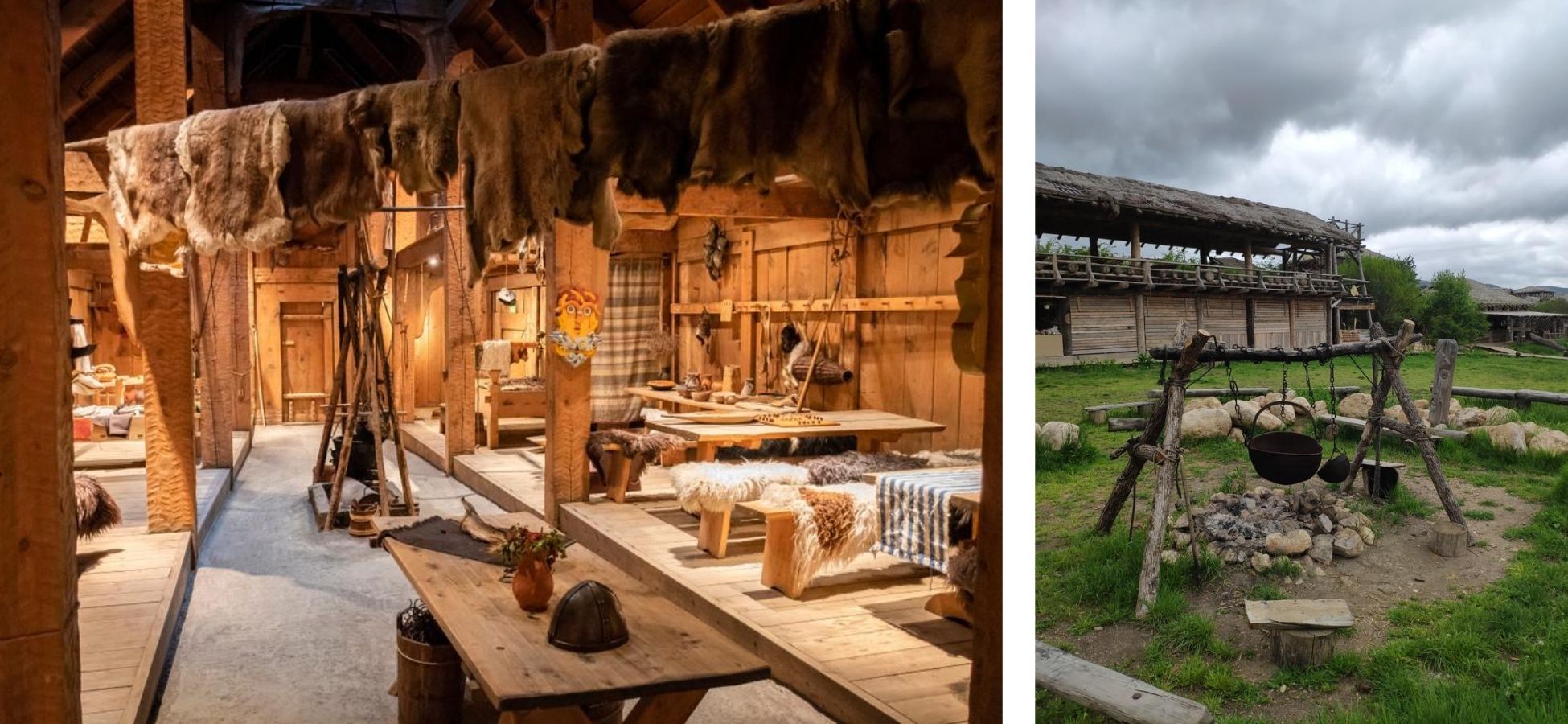
Reconstruction of Viking houses, Iceland – Photo credit: Shutterstock – Matt Ledwinka & Mars0hod
Then, around 930, the decision to create a general assembly was taken: thus the Icelandic Free State was born. Everything then accelerates. Several emissaries are instructed to travel to their homelands to study the laws there. The objective: to agree to create new ones for all the peoples living in Iceland. Also, a place for this meeting must be found.
Easily accessible by all peoples, this place must allow everyone to gather, to share but also to celebrate. And as so often in life, it’s all about timing. While the search for this place turns out to be more complex than expected, a farmer, resident of the Thingvellir region, is tried at the same time for murder. In addition to a fine, he was forced to abandon his land, which then became public property.
Thingvellir, the first parliament in history, Iceland – Photo credit: Shutterstock – Mike Ver Sprill
Perfectly located between the most populated regions, it has wood for the fire, meadows for the horses. Above all, it is located in the hollow of a rocky fault, creating a perfect echo so that the speakers of the assembly can be heard by all.
Thingvellir, the oldest parliament in history
We are in 930, in Thingvellir in Iceland, and the Vikings have just created the first parliament in history. An assembly made up of 36 local chiefs, of clans with various influences, and bearing the name of Althing .
Thus, each year, hundreds of Vikings from Iceland – landowners – meet at the summer solstice for a period of fifteen days, in order to put down all the quarrels and resentments present between the different clans. A president is elected there for 3 years, and holds the legislative and judicial power for all of Iceland. On the other hand, executive power remains in the hands of each clan chief.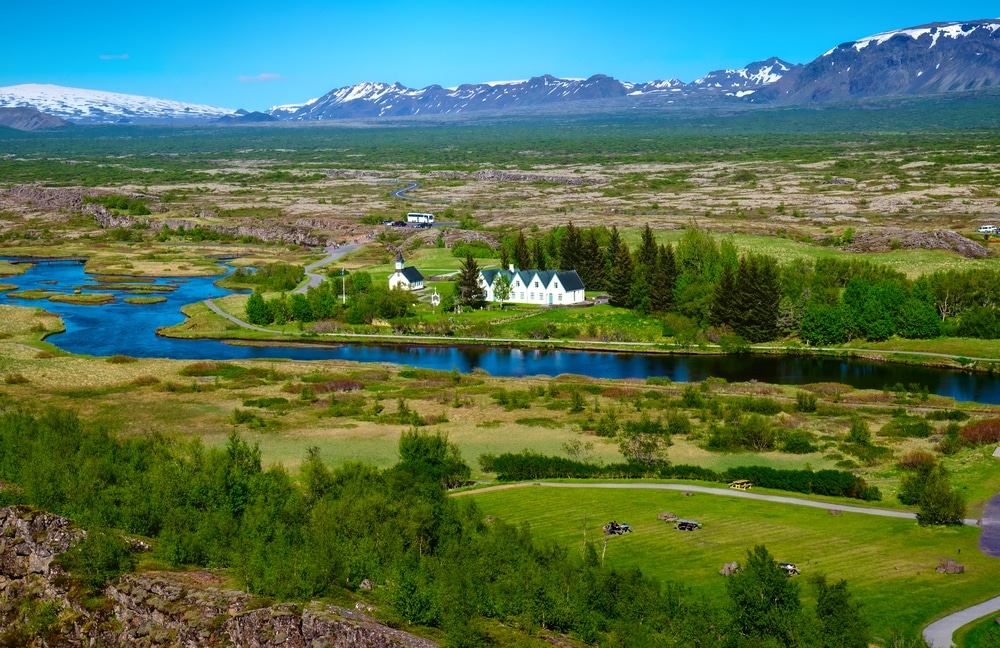
Thingvellir National Park, Iceland – Photo credit: Shutterstock – elxeneize
The president, named the “lögsögumad” – the one who says the law -, has the most important role of this assembly. Above all, the latter was responsible, each year, for reciting a third of the laws of the country, so that no one would forget them. He then stood next to the “Rock of the Law”, and listed each of the laws that had not been mentioned in the previous two years. Indeed at the time, the pagans did not have any text of written law. Remember, the first text written by the hand of the “Vikings” dates back to Landnámabók, which appeared almost two centuries later…
But if at the Althing , we settle conflicts in a rather light and organized atmosphere, we meet there mainly to celebrate. Games, dances, horse races, and above all, transmissions of Viking stories. The beginning of the sagas! So, we evoke the great Ragnar Lodbrok and his great English invasions, his legendary courage and his death in a snake pit, with a smile on his face, ready to join his gods in Valhalla.
Portraits of Ragnar Lodbrok – Photo credit: Wikipedia – Hugo Hamilton
He, the legendary Viking, who had initiated the Christianization of his people, with the aim of making them a cultured and well-meaning civilization, a peacemaker.
Thingvellir’s Big Decision
The most important decision taken by the assembly of Althing will remain the one which will have completely changed the History and the future of the Vikings. In the year 1000, two Icelandic goðar – chieftains – speak near the rock of the law, to try to convince the Icelanders to Christianize, as they had promised to the Norwegian king at the time, Olaf Tryggvason .
But the Vikings are not for it, and the debates are heated. Gissur le blanc , one of the goðar , appeals to the memory of Ragnar Lodbrok to justify this choice, leaving some Vikings in doubt at the same time. After a night of uninterrupted discussions, it is up to the president, the “lögsögumad” to decide. The decision is made: in this year 1000, the Vikings become Christians. However, it grants those who wish the right to perpetuate the pagan cult, but with certain discretion.
If the History of the Vikings subsequently takes many detours until it disappears, the Althing endures in time. Resisting the Norwegian and Danish takeovers, the Althing nevertheless gradually lost its power, until 1662. Then, Iceland and its free state found themselves subject to Danish absolutism. Thingvellir in turn becomes a place of legend. A place that is quoted in poems, such as that of Jónas Hallgrímsson in 1835, telling us of the emotional power still present in Thingvellir.
So if your steps one day lead you to Iceland, head inland and walk to this Almannagjá fault. Then close your eyes, and listen to the “lögsögumad” tell you the Viking legends. Smell the smell of horses and the sound of their hooves clicking on the ground. Imagine the power of this people, so strong that you can still feel it, after more than a millennium.
3. The legendary Icelandic waterfalls
Our story, linking the legendary Viking people to the fabulous lands of Iceland, continues to the present. If the Vikings are gone, their stories will never stop being told, just like the water in Icelandic waterfalls will never stop flowing.
Skógafoss

Skogafoss, Iceland – Photo credit: Shutterstock – StandARTP
The first waterfall on our journey is Skógafoss, and it tells us the tale of its hidden treasure. This sublime waterfall takes its name from the Skóga river – translate “forest” -, and flows over a width of 25 meters, to come and throw itself some 62 meters below, at an impressive intensity. And if it is one of the most visited waterfalls in the country, it is because it is the source of a legend… A Viking legend.
Þrasi Þórólfsson , a Viking from the time of the Althingi, is said to have deposited his treasure in the greatest secrecy, behind the rampart formed by this waterfall. A treasure that would make whoever finds it the richest man in the world. A few years later, a young child, playing near the waterfall, reportedly saw the shiny gold coins on the other side of the waterfall. If the child could not seize the treasure, he still managed to extricate a handful. A small part of treasure that you can also admire at the Skógar museum.
But ultimately, as you pass by this sublime waterfall, you may realize that the real treasure of the place lies in its majesty. Open your eyes, strain your ears, and become rich with the powerful energies escaping from the waterfall.
Godafoss
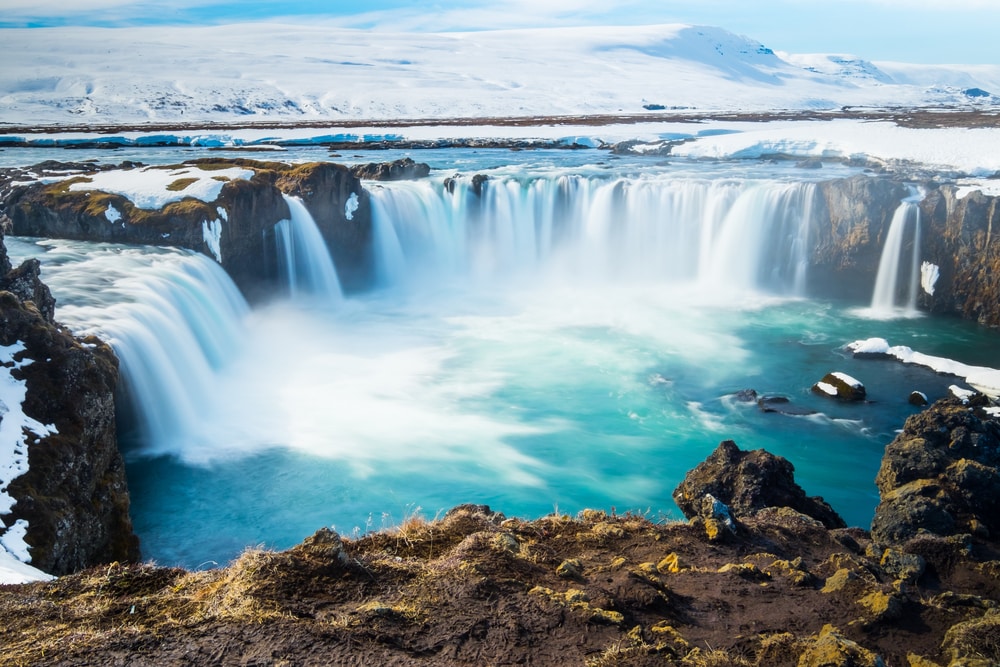
Godafoss, Iceland – Photo credit: Shutterstock – Puripat Lertpunyaroj
As our journey in the footsteps of the Vikings in Iceland is coming to an end, we still have a few wonders to discover. After the power of Skógafoss, it is to the very north of the country of ice that we head, in search of Godafoss, the waterfall of the gods.
12 meters wide, 30 high, its flow is as intense as the noise that emerges from it. Here, it is impossible to hear oneself speak, breathe, or even think. You find yourself almost oppressed by the power of the water which seems to want to draw you to the bottom of its abyss. As if someone were trying to pull your soul deep into these troubled waters.
And the shock is all the stronger when you learn the history of this place, more than a millennium old. Remember, we are in the year 1000 when the Althing takes the decision for the Icelandic Viking people to convert to Christianity. So, to set an example, the “lögsögumad” (the one who made the final decision) goes to the top of this waterfall, and throws all the representations of the old pagan gods into the water.
This is how this waterfall was named Godafoss, the waterfalls of the gods.
Seljalandsfoss

Seljalandsfoss – Crédit photo : Shutterstock – Olga Gavrilova
Like the pagan civilization, it is in the hollow of this waterfall that our story ends. Indeed, it is at this sublime place that we could assimilate the end of the Viking era, at least on Icelandic lands.
We are then at the birth of the second millennium, and the Vikings are no longer a pagan population, but a Christian people. While some continue to worship their ancient gods, the practice is increasingly seen as an act of rebellion against the King of Norway.
Then, the last Vikings not wanting in any case to give up their beliefs, take refuge towards the south. A flight that will lead them to this fabulous place, the Seljalandsfoss waterfall. The characteristic of this waterfall is in the possibility of bypassing it to hide behind it.
Seljalandsfoss, Iceland – Crédit photo : Shutterstock – Zebra-Studio
According to legend, it is here, entrenched as during their famous combat technique, and in a very small population like their first steps on these Icelandic lands that the Vikings slowly died out, clinging to their conviction.
But if the Viking people no longer exist, their legend remains fiercely attached to these landscapes, wild, unique, precious. From the Snaeland discovered by Naddoddr to the Iceland of Flóki, the Icelandic legends are therefore closely linked to those of the Vikings, a people of explorers, thirsty for discoveries and desires elsewhere.
Travel needs that do not stop here, and which will soon lead them to the discovery of the American continent, half a century before Christopher Columbus. To be continued…
Did you like this article? Do not hesitate to share it on social networks and subscribe to Discover the World on Google News to not miss any articles!